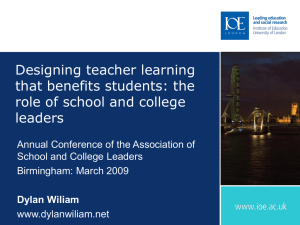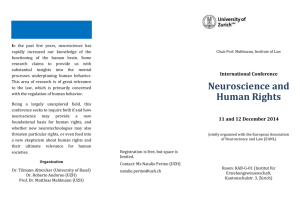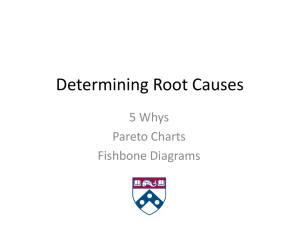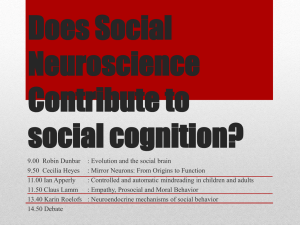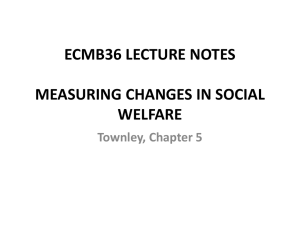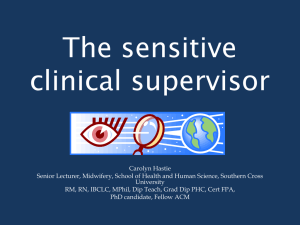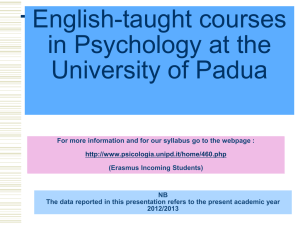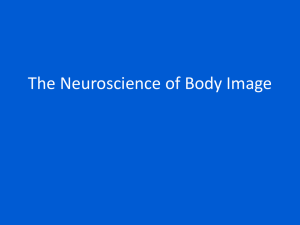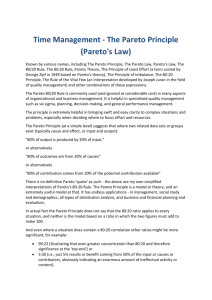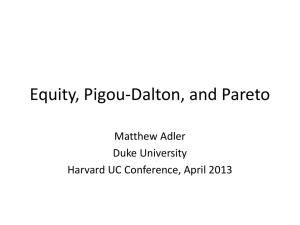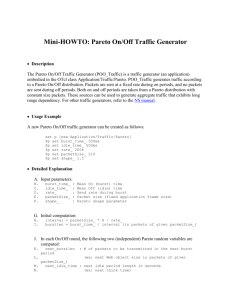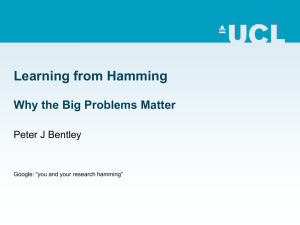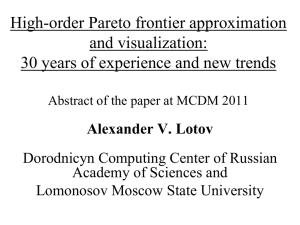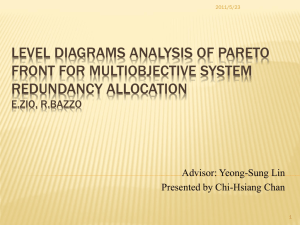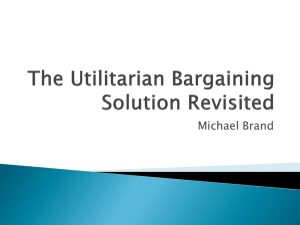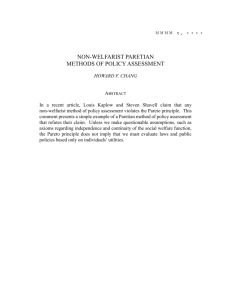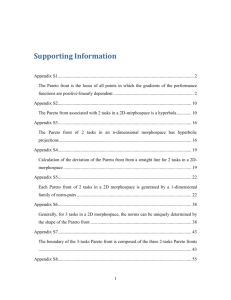Breakout session at Alberta Assessment Consortium Fall Conference
advertisement
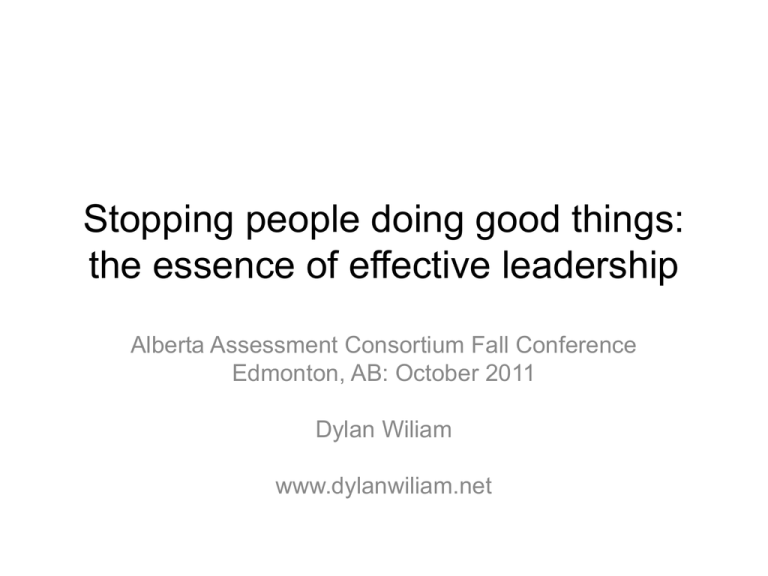
Stopping people doing good things: the essence of effective leadership Alberta Assessment Consortium Fall Conference Edmonton, AB: October 2011 Dylan Wiliam www.dylanwiliam.net Improving schools: where’s the solution? • Structure – Smaller/larger high schools – K-8 schools/”All-through” schools • Alignment – Curriculum reform – Textbook replacement • Governance – Charter Schools – Vouchers • Technology – Computers – Interactive white-boards • Workforce reforms School effectiveness • Three generations of school effectiveness research – Raw results approaches • Different schools get different results • Conclusion: Schools make a difference – Demographic-based approaches • Demographic factors account for most of the variation • Conclusion: Schools don’t make a difference – Value-added approaches • School-level differences in value-added are relatively small • Classroom-level differences in value-added are large • Conclusion: An effective school is a school full of effective classrooms 20 0 -60 -80 40 Iceland . Finland . Norway . Sweden . Poland . Denmark . Ireland . Canada . Spain . New Zealand . Australia . United States . Mexico . Portugal . Luxembourg . Switzerland . Greece . Slovak Republic . Korea . Czech Republic . Netherlands . Austria . Germany . Italy . Belgium . Japan . 80 Hungary . Turkey . Canada 100 Within schools 60 -20 -40 Between schools Within schools Between schools explained by social background of schools Between schools explained by social background of students Between schools not explained by social background OECD PISA data from McGaw, 2008 We need to focus on classrooms, not schools • In Canada, variability at the classroom level is at least 4 times that at school level – As long as you go to school, it doesn’t matter very much which school you go to – But it matters very much which classrooms you are in… • It’s not class size • It’s not the between-class grouping strategy • It’s not the within-class grouping strategy …and most of all, on teachers • Take a group of 50 teachers – Students taught by the most effective teacher in that group of 50 teachers learn in six months what those taught by the average teacher learn in a year – Students taught by the least effective teacher in that group of 50 teachers will take two years to achieve the same learning (Hanushek, 2006) • And furthermore: – In the classrooms of the most effective teachers, students from disadvantaged backgrounds learn at the same rate as those from advantaged backgrounds (Hamre & Pianta, 2005) Improving teacher quality takes time… • A classic labor force issue with 2 (nonexclusive) solutions – Replace existing teachers with better ones – Help existing teachers become even more effective • Replace existing teachers with better ones? – Increasing the quality of entrants to exclude the lowest performing 30% of teachers would in 30 years, increase average teacher quality by 0.5 standard deviations. – Cumulatively, one extra student passing a test per class every three years… …so we have to help the teachers we have improve… • Improve the effectiveness of existing teachers – The “love the one you’re with” strategy – It can be done • Provided we focus rigorously on the things that matter • Even when they’re hard to do Teachers do improve, but slowly… Extra months per year of learning 0.5 0.4 0.3 0.2 0.1 Literacy Numeracy 0 0 5 10 15 20 25 -0.1 -0.2 -0.3 -0.4 Years in service Leigh, A. (2007). Estimating teacher effectiveness from two-year changes in student test scores. People like neuroscience • Descriptions of 18 psychological phenomena – Example: curse of knowledge • Designed to be comprehensible without scientific training • Each phenomenon was given four possible explanations – Basic (without neuroscience) • Good explanation (provided by the researchers) • Bad explanation (e.g., circular reasoning) – Enhanced (with neuroscience explanation) • Good explanation • Bad explanation • Added neuroscience did not change the logic of the explanation • Participants randomly given one of the four explanations • Asked to rate this on a 7-point scale (-3 to +3). Sample explanations Good explanation Bad explanation Without neuroscience The researchers claim that this ‘curse’ happens because subjects have trouble switching their point of view to consider what someone else might know, mistakenly projecting their own knowledge onto others. The researchers claim that this ‘curse’ happens because subjects make more mistakes when they have to judge the knowledge of others. People are much better at judging what they themselves know. With neuroscience Brain scans indicate that this ‘curse’ happens because of the frontal lobe brain circuitry known to be involved in selfknowledge. Subjects have trouble switching their point of view to consider what someone else might know, mistakenly projecting their own knowledge onto others. Brain scans indicate that this ‘curse’ happens because of the frontal lobe brain circuitry known to be involved in selfknowledge. Subjects make more mistakes when they have to judge the knowledge of others. People are much better at judging what they themselves know. Seductive allure Without neuroscience With neuroscience Explanation Good Bad Good Bad Novices (n=81) +0.9 –0.7 +0.9 +0.2 Students (n=22) +0.1 –1.1 +0.7 +0.2 Experts (n=48) +0.5 –1.1 –0.2 –0.8 (Weisberg et al., 2008) Brains recognizing words Group-level activations for recognition of words versus a baseline condition (Miller, et al., 2002) Dissociation in the brain representation of Arabic numbers between native Chinese speakers and native English speakers (Tang et al., 2008) A case study in one district • Cannington – Urban school district serving ~20,000 students – Approximately 20% of the population non-white – No schools under threat of re-constitution, but all under pressure to improve test scores • Funding for a project on “better learning through smarter teaching” – Focus on mathematics, science and modern foreign languages (MFL) – Commitment from Principals in November 2007 – Initial workshops in July 2008 Progress of TLCs in Cannington Maths Science MFL Ash 1 — 1 — 0 — Cedar 5 ▮ 1 ▮ 3 ▮▮ Hawthorne 4 ▮▮ 10 ▮ ▮ 5 ▮▮▮▮ Hazel 7 — 12 — 2 — Larch 1 ▮▮▮▮ 0 ▮ 0 ▮ Mallow 6 ▮▮▮ 7 ▮ 3 ▮▮ 3 ▮▮▮ 1 ▮▮▮ Poplar 11 ▮ Spruce 7 ▮▮▮▮ 8 ▮▮▮ 5 ▮▮▮ Willow 2 ▮ 5 ▮ 2 ▮▮▮▮ Totals 44 47 21 Black nos. show teachers attending launch event; blue bars show progress of TLC Pareto analysis • Vilfredo Pareto (1848-1923) – Economist and philosopher • Pareto improvement – A change that makes at least one person better off without making anyone else worse off. • Pareto efficiency/Pareto optimality – An allocation of resource is Pareto optimal when there are no more Pareto improvements • Obstacles to Pareto improvements – The political economy of reform – It is very hard to stop people doing valuable things in order to give them time to do even more valuable things Cake or death? Cost/effect comparisons Extra months of learning per year Cost/classroom/yr Class-size reduction (by 30%) 4 $30k Increase teacher content knowledge from weak to strong 2 ? Formative assessment/ Assessment for learning 8 $3k Intervention Teacher learning • Teacher learning is just like any other learning in a highly complex area – In the same way that teachers cannot do the learning for their learners – Leaders cannot do the learning for their teachers • Two extreme responses – “It’s hopeless” – Let a thousand flowers bloom.. • Neither will work – What leaders can do is engineer effective learning environments for teachers The knowing-doing gap Statement We know we should do this We are doing this Getting good ideas from other units in the chain 4.9 4.0 Instituting an active suggestions program 4.8 3.9 Using a detailed assessment process for new hires 5.0 4.2 Posting all jobs internally 4.2 3.5 Talking openly about learning from mistakes 4.9 4.3 Providing employees with frequent feedback 5.7 5.2 Sharing information about financial performance 4.3 3.8 Pfeffer, J. (2000). The knowing-doing gap. Cambridge, MA: Harvard Business School Press. Control and impact Control Inside Low Impact High Outside Why people shouldn’t work on their own Strangers predict your IQ better than you do (Borkenau & Liebler, 1993) Most of us think we are above average drivers (Svenson, 1981) Only 2% of high school seniors believe their leadership skills are below average (College Board, 1976/1977) …and 25% of them believe they are in the top 1% in their ability to get along with others (College Board, 1976/1977) 94% of college professors report doing above average work (Cross, 1997) People think they are at lower risk than their peers for heart attacks, cancer, food poisoning, etc. (Weinstein, 1980) And, most surprisingly… People believe they are better than their peers at providing accurate self assessment (Pronin, Lin, & Ross, 2002) What is a Professional Learning Community? “…an inclusive group of people, motivated by a shared learning vision, who support and work with each other, finding ways, inside and outside their immediate community, to enquire on their practice and together learn new and better approaches that will enhance all pupils’ learning.” (Stoll et al., 2006) Professional learning communities • Professional – Decision-making under uncertainty – Accountable to a community of peers • Learning – Focused on improvement in student outcomes • Communities – Joint enterprise – Mutual engagement – Shared repertoire Professions in comparative perspective Medical education Teacher education People-centred profession? ✔ ✔ Agreed body of knowledge? ✔ ✘ Shared language of description? ✔ ✘ Cumulating research? ✔ ✘ Practitioners involved in research ✔ ✘ ‘Keeping up with research’ regarded as a professional duty ✔ ✘ Context matters Tight, but loose • Two opposing factors in any school reform – Need for flexibility to adapt to local constraints and affordances • Implies there is appropriate flexibility built into the reform – Need to maintain fidelity to the theory of action of the reform, to minimise “lethal mutations” • So you have to have a clearly articulated theory of action • Different innovations have different approaches to flexibility – Some reforms are too loose (e.g., ‘Effective schools’ movement) – Others are too tight (e.g., Montessori Schools) • The “tight but loose” formulation: – … combines an obsessive adherence to central design principles (the “tight” part) with accommodations to the needs, resources, constraints, and affordances that occur in any school or district (the “loose” part), but only where these do not conflict with the theory of action of the intervention. Design and intervention Our design process cognitive/affective insights synergy/ comprehensiveness set of components Teachers’ implementation process set of components synergy/ comprehensiveness cognitive/affective insights The happiness hypothesis (Haidt, 2005) + – The rider Rational Good at complex analysis Focused on the long-term Thinks about the future Weak Easily distracted Gets bogged down in detail Tires quickly The elephant Instinctive Compassionate Sympathetic Loyal Protective Powerful Emotional Skittish Focused on the short-term Thinks about the present Strategies for change (Heath & Heath, 2010) • Direct the rider – Follow the bright spots – Script the critical moves – Point to the destination • Motivate the elephant – Find the feeling – Shrink the change – Grow your people • Shape the path – Tweak the environment TLC case study 1: Edmonton County School TLC case study 2: St. Wilfrid’s RC High School Teacher Quotes • “I have been the most impressed with how much more involved my students have been in their own learning…their confidence in their efforts has been wonderful.” • Here [school based TLC] we had techniques sort of embedded in this group where, you know, we are talking about problems. And our group really actually talked about problems, and we were all GUYS, and older guys too. We actually talked and that doesn’t happen. That doesn’t happen, so I enjoyed the group a lot and thought it was very useful.” • “This work, has really changed what I do – more than most things. When you stop grading papers with numbers, that’s a big deal!” 37 Impact: on teachers Impact: on students Impact at Edmonton County School Teacher Quotes • “We don’t have to have ‘cookie cutter’ classrooms, where we’re all on the same page. There’s an atmosphere here that supports innovation. We can individualize…we’re encouraged to try new things and we’re given time to share with our colleagues.” 41 Membership of PLCs Volunteers Benefits Risks Culture deepens quickly Non-volunteers left behind Appealing to ‘keen’ teachers Conscripts Oppositional sub-culture less likely ‘Project mentality’ disconnected from practice Differences in approach can be used to deepen conversations Tokenistic adoption When is change sustainable? • Understanding what it means to scale (Coburn, 2003) – Depth – Sustainability – Spread – Shift in reform ownership • Consideration of the diversity of contexts of application • Clarity about components, and the theory of action Key stakeholders’ reactions • • • • • • • • Departmental sub-cultures Unions Professional associations Teaching assistants Ofsted Parents Governors Community leaders Cost profile of innovations “Big bang” Annual Cost “Steady-state” Annual Cost Time Time “Focused expansion” “Inflationary” Annual Cost Annual Cost Time Time Managing disappointments • • • • • • Failure: opportunity for learning or blame Falling down: failing or learning? High-reliability organizations embrace failure $1m dollar club “A complaint is a gift” Group-work is hard for teachers, … and for teachers of teachers… A case study in risk • Transposition of the great arteries (TGA) – A rare, but extremely serious, congenital condition in newborn babies (~25 per 100,000 live births) in which • the aorta emerges from the right ventricle and so receives oxygen-poor blood, which is carried back to the body without receiving more oxygen • the pulmonary artery emerges from the left ventricle and so receives the oxygen-rich blood, which is carried back to the lungs – Traditional treatment: the ‘Senning’ procedure which involves: • the creation of a ‘tunnel’ between the ventricles, and • the insertion of a ‘baffle’ to divert oxygen-rich blood from the left ventricle (where it shouldn’t be) to the right ventricle (where it should) – Prognosis • Early death rate (first 30 days): 12% • Life expectancy: 46.6 years The introduction of the ‘switch’ procedure Senning Early death rate Senning 12% Transitional 25% Transitional Switch Bull, et al (2000). BMJ, 320, 1168-1173. Impact on life expectancy Life expectancy: Senning: 46.6 years Switch: 62.6 years Force-field analysis (Lewin, 1954) • What are the forces that will support or drive the adoption of teacher learning communities in your school/district/province? + • What are the forces that will constrain or prevent the adoption of teacher learning communities in your school/district/province? —

